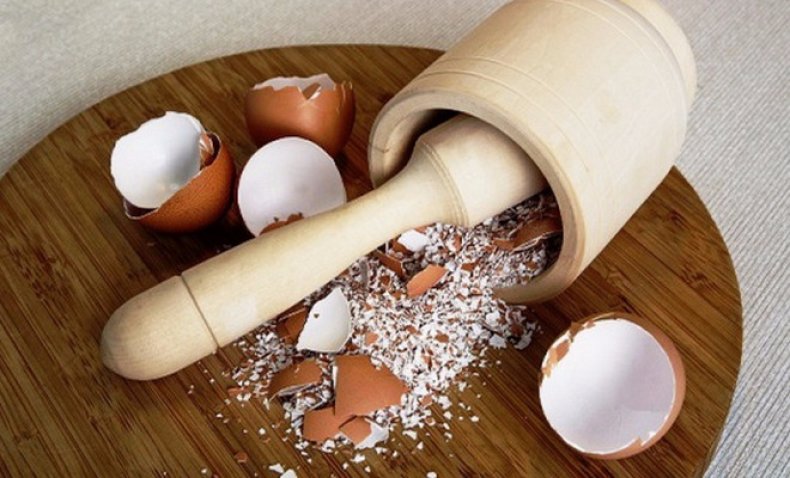 The value of eggshell as a fertilizer is due to the high content of calcium and other micro and macro elements in it, which are necessary for garden crops for healthy development and good fruiting.
The value of eggshell as a fertilizer is due to the high content of calcium and other micro and macro elements in it, which are necessary for garden crops for healthy development and good fruiting.
The shell can be used for feeding potatoes, bell peppers, eggplant, cauliflower. But the fertilizer gained the most popularity as a means to increase the yield of cucumbers and tomatoes.
Content
The benefits of eggshells for tomatoes and cucumbers
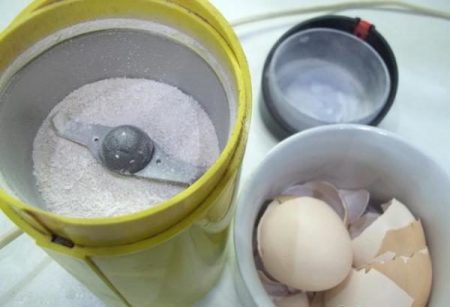 Egg shell fertilizer is used for root dressing. The shell not only nourishes the plants, but also beneficially affects the quality of the soil:
Egg shell fertilizer is used for root dressing. The shell not only nourishes the plants, but also beneficially affects the quality of the soil:
- Saturation with calcium. The shell contains a large concentration of the element, and most importantly, in a form easily digestible by plants.
- Decrease in acidity. Both cucumbers and tomatoes need neutral or slightly acidic soils. The advantage of the shell over such liming agents as chalk or lime is that it is more quickly “perceived” by the soil.
- Improving the structure. Heavy, clay soils are not suitable for growing tomatoes and cucumbers. The introduction of crushed shells makes the soil loose and breathable. This effect persists for several years, because the eggshell decomposes very slowly.
The minimum decomposition period of the product (when rotting in a compost pit) is at least 2 years. In the soil, complete processing occurs no faster than the decomposition of bone tissue. But, despite the strength of the shell, nutrients from it are released intensively, quickly increasing the fertility of the soil.
Valuable items
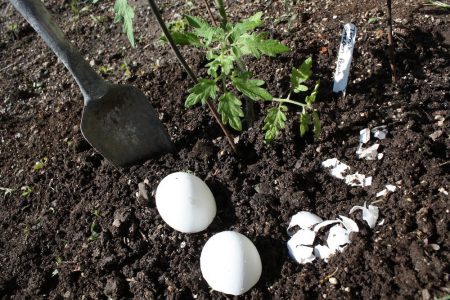 In addition to calcium, the shell is a source of other minerals useful for tomatoes and cucumbers.
In addition to calcium, the shell is a source of other minerals useful for tomatoes and cucumbers.
| element | content in 100 g | use item for cucumbers | element use for tomatoes |
| calcium | 34-37 g |
Seed germination; · Root system development; · Building green mass; Immunity to diseases · Resistance to temperature extremes; · Fruit growth; · Improving the taste of fruits; · Increase the keeping quality of fruits. |
Seed germination; · Root system development; · Growth of shoots; Ovary formation; · Fruit growth. |
| iron | 2.8 g |
· Building green mass; · Stimulation of flowering. |
· Growth of shoots; · The formation of ovaries. |
| sulfur | 0.6-1.2 g |
· Growth of shoots; · Formation of ovaries; · Improving the taste of fruits. |
|
| zinc | 0.4-0.6 g |
· Formation of ovaries; · Fruit growth.
|
· Fruit growth; · Improving the taste of fruits. |
| phosphorus | 121-188 mg |
· Root system development; · Growth of lashes; · Stimulation of flowering; · The formation of ovaries. |
· Root system development; · Formation of ovaries; · Fruit growth; Ripening fruits; · Improving the taste of fruits. |
| magnesium | 106-113 mg |
Flowering Ovary formation; · Growth and ripening of fruits; · Improving the taste of fruits. |
· Formation of ovaries; · Improving the taste of fruits. |
| copper | 92-150 mg |
· Formation of ovaries; · Fruit growth.
|
· Growth of shoots; · Root system development; · Flower formation. |
| potassium | 83-93 mg |
· Resistance to adverse weather conditions; Immunity to diseases · Fruit growth. |
Immunity to diseases · Resistance to adverse weather conditions; · Formation of ovaries; · Fruit growth; Ripening fruits; · Improving the taste of fruits. |
| iodine | 34-60 mg |
· Stalk growth; · Strengthening of immunity; Accumulation of vitamin C in fruits. |
· Formation of ovaries; · Improving the taste of fruits. |
| molybdenum | 28-36 mg |
· Formation of ovaries; · Improving the taste of fruits. |
Collection and preparation of raw materials
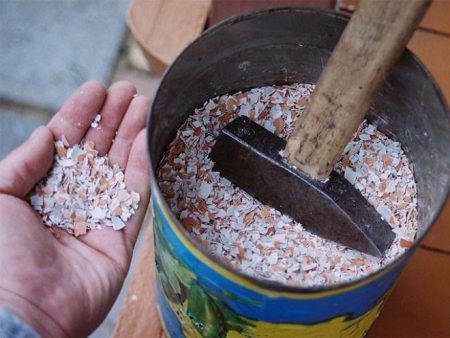 For fertilizer, not only the shell of eggs is suitable, you can use the "products" from any poultry. Quail eggs are considered the most useful, since their shell contains the largest amount of trace elements.
For fertilizer, not only the shell of eggs is suitable, you can use the "products" from any poultry. Quail eggs are considered the most useful, since their shell contains the largest amount of trace elements.
For the same reason, raw shells are more valuable - under the influence of high temperatures when cooking eggs, some of the nutrients are lost. Nevertheless, it is recommended that the raw materials be calcined in the oven - the loss in this case is offset by a more active release of calcium.
When harvesting raw materials should focus on the size of the landing. About 40-50 eggs are required to improve soil quality per square of beds. But with proper processing and storage, the shell may not lose its useful qualities throughout the year, so it is not difficult to accumulate the required amount.
It is more advisable to acquire eggs of brown color, because their shell is thicker than white. All other things being equal, eggs laid in the winter have the most dense shell.
How to store egg nutrition
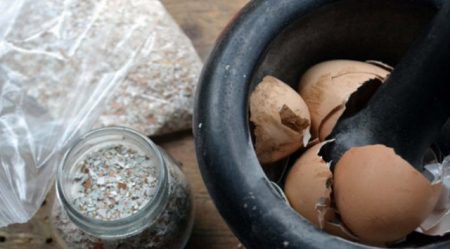 To prevent raw materials from deteriorating during storage, the shell must be thoroughly washed and dried. Drying in the oven is preferable, since it destroys bacteria and fungi that can start rotting processes.
To prevent raw materials from deteriorating during storage, the shell must be thoroughly washed and dried. Drying in the oven is preferable, since it destroys bacteria and fungi that can start rotting processes.
Dry shell is ground in a mortar or coffee grinder and placed in a paper bag. Do not store in glass, plastic containers or plastic bags - these materials are impervious to air, so there is a risk of rotting and spoiling of raw materials. The appearance of an unpleasant odor from the powder indicates that the product is spoiled.
Egg Shell Fertilizer Recipes
Egg shells can be applied to garden crops in dry or liquid form, having prepared an infusion from it. We can say that dry top dressing is a strategic, infusion is a tactical tool. Liquid top dressing allows you to quickly saturate the plant with calcium, but will not enrich the soil, while dry shells are absorbed more slowly, but allow the soil to be saturated with calcium.
- Dry top dressing. The crushed eggshells are added to the hole for planting seedlings, or mixed with soil during digging.
- Infusion. Ground raw materials must be poured with boiling water at the rate of 1 liter per shell of 10 eggs and let it brew for five to seven days. From time to time, the infusion should be shaken and mixed, stimulating the fermentation process. At the end of the term, the fertilizer is used by diluting with 3 parts of water. Filtering the infusion is not necessary.
To reduce soil acidity
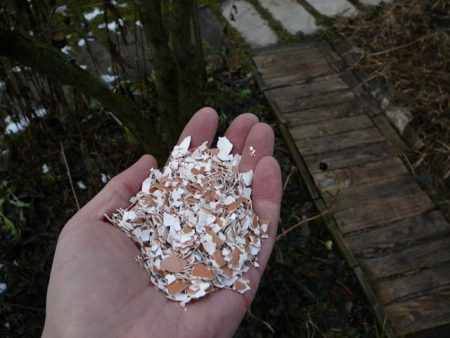 Use shell powder by mixing it with soil. For liming pronouncedly acidic soil, about 0.5 kg of calcium carbonate per 1 m2 is required. Therefore, you need to make 1.5 kg of raw materials per 1 m2 of beds. The shell weight of the chicken egg is about 5 g, that is, about 300 eggs will be required. For very acidic and heavy soils, this figure needs to be increased by 2 times.
Use shell powder by mixing it with soil. For liming pronouncedly acidic soil, about 0.5 kg of calcium carbonate per 1 m2 is required. Therefore, you need to make 1.5 kg of raw materials per 1 m2 of beds. The shell weight of the chicken egg is about 5 g, that is, about 300 eggs will be required. For very acidic and heavy soils, this figure needs to be increased by 2 times.
But this amount of fertilizer can not be applied at a time. Liming of an egg shell should be carried out regularly for several years in a row, only in this case can a stable and high-quality result be obtained. The procedure is recommended to be carried out 2 times a year - when digging beds in the spring and autumn. In the first year, a total of about 250 grams of product (50 eggs) per 1 m2 must be introduced.
Errors in using fertilizer
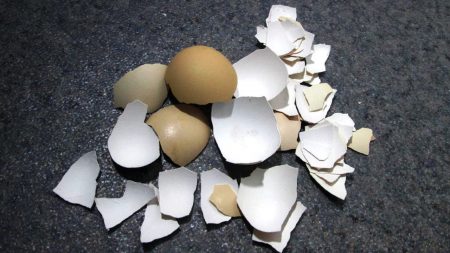 Despite the naturalness and benefits, the use of eggshells as fertilizer has its limitations.
Despite the naturalness and benefits, the use of eggshells as fertilizer has its limitations.
Do not do it:
- Exceed dosage. Excess calcium in the soil prevents the absorption of other useful elements - potassium, boron, manganese, copper, zinc.
- Use fresh or poorly shelled shells. This can attract pests to the planting. In addition, egg white, getting into the soil, becomes a favorable environment for the development of bacteria, provoking plant diseases.
- Use large fragments. The finer the fraction of raw materials, the more trace elements will be available to plants. Ideally, the shell should be crushed into powder.
- Sprinkle fertilizer on top of the soil. The process of assimilation of nutrients in this case will be too long.
Dusting seedlings of tomato powder with eggshell helps protect plants from the disease by rotting the root neck (black leg).
Application of egg top dressing for cucumbers and tomatoes
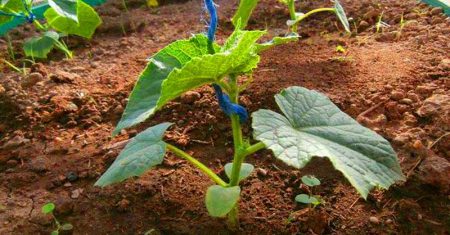 For cucumbers, calcium is significant in the early stages of development. Since the element stimulates the growth of the roots and aerial parts of plants, and also increases resistance to adverse conditions, egg shell feeding is primarily useful for seedlings after planting in the soil during active growth.
For cucumbers, calcium is significant in the early stages of development. Since the element stimulates the growth of the roots and aerial parts of plants, and also increases resistance to adverse conditions, egg shell feeding is primarily useful for seedlings after planting in the soil during active growth.
Options for feeding cucumbers
- To prepare the seedlings of cucumbers for transplantation, they are sprayed with liquid fertilizer from the shell 5-7 days before planting in the ground.
- In order to improve root growth and a set of green mass, as well as help plants adapt after transplantation, 2 teaspoons of shell powder should be put in the hole for planting seedlings.
- Since the germination of cucumbers is not very good, egg powder can also be useful as a stimulator of seed germination. It is necessary to sprinkle sowing with a thin layer of egg powder (before the seeds fall asleep with a substrate).
- It is useful to mulch seedlings of cucumbers planted in open ground with a mixture of compost and shell. To do this, add 500 g of powder per 10 kg of compost.
Tomatoes also need calcium at the beginning of the growing season. In addition, calcium top dressing is recommended during the ripening period. The element is also required for tomatoes to form ovaries, but during flowering they do not give top dressing - the plant spends the reserves previously accumulated in the tissues.
Topping Tomatoes
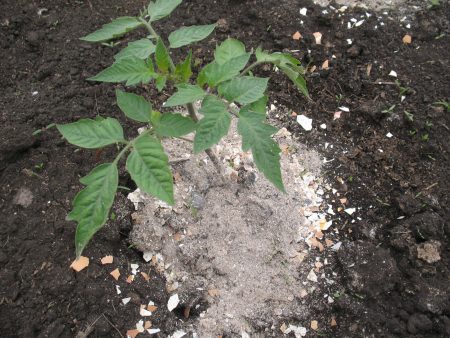
- To enhance the ability to adapt seedlings, to improve the growth of shoots and roots, before planting in the ground, you need to water the infusion from the shell twice. The first time - at the stage of 2 leaves, the second - 10 days after the dive.
- As for cucumbers, a teaspoon of ground shell can be put in a hole for planting tomato seedlings. They also use it to stimulate seedlings of tomatoes.
- Instead of dry top dressing, which is introduced during transplantation, young tomatoes can be watered with infusion 9-10 days after planting.
- During the fruit filling period, tomatoes are watered with 0.5 liters of infusion per bush. Watering can be repeated after 2-3 weeks.
Calcium deficiency in cucumbers and tomatoes
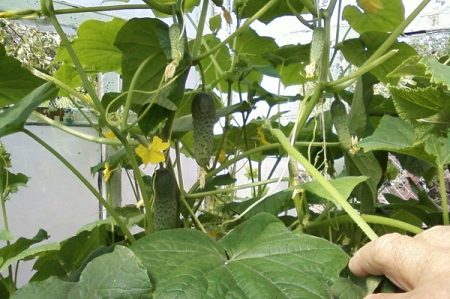 A lack of calcium can lead to growth retardation, weakening of the root system, damage to the tops of tomatoes and cucumbers, as well as damage to the tomato crop.
A lack of calcium can lead to growth retardation, weakening of the root system, damage to the tops of tomatoes and cucumbers, as well as damage to the tomato crop.
Calcium deficiency in cucumbers manifests itself:
- the appearance of a yellow border around the edge of the sheet;
- light stripes on a sheet plate;
- twisting the leaves with the edges down, loss of turgor and necrosis;
- chopping and dark green coloring of young leaves;
- the death of the tops of the shoots, starting from the main stem;
- wrinkling of fruits.
Symptoms of calcium deficiency in tomatoes:
- yellow spots on young leaves;
- darkening of the color of old leaves;
- deformation and drying of leaves;
- the death of the tops;
- accelerated ripening of fruits;
- the appearance of apical rot on the fruit.
With signs of calcium deficiency, it is necessary to quickly saturate the plant with an element. For cucumbers in this case, there is a recipe for acidified tincture from the shell. To prepare it, 30-40 g of powder is poured into 0.5 liters of water with the addition of a teaspoon of vinegar. Insist in a dark place for three days, after which the cucumbers are watered without diluting with water. Such top dressing is effective in the case of a lack of magnesium.
It is impossible to use acetic-egg solution for feeding tomatoes. In the case of a lack of calcium, it is recommended that foliar top dressing with a solution of calcium nitrate (0.2%).
Tips and reviews of gardeners
Julia, 38 years old:
“I use eggshells for liming the garden earth with wood ash. Both drugs reduce acidity, in addition, an excellent nutrient mixture is obtained - eggshell gives calcium, ash - potassium, phosphorus. Especially useful for tomato, fruits grow noticeably more. By the way, the shell can not be calcined in the oven, but immediately fry at the stake with ash. "
Anton, 58 years old:
“The shell can be sprinkled into the soil along with mineral fertilizers that increase the acidity of the soil. For example, ammonium sulfate, ammonium nitrate, potassium sulfate, colloidal sulfur. On acidic soils, they are not recommended for use, but it is not always possible to refuse these top dressings. The shell compensates for acidification and is useful in itself. ”
Victoria, 42 years old:
“The common advice to grow seedlings in shells should not be taken as top dressing. Too large pieces of shell remain in the soil so that plants can absorb calcium from them in the current season. Of course, gradual improvement of the soil will occur, but not immediately. But such a cultivation, when plants are planted in open ground right in these "pots", is useful because the roots are not injured during transplantation. Cucumber seedlings are struggling to adapt in a new place, so the method is good. The main thing is not to forget to crush the shell before planting with your fingers (lightly so as not to damage the roots). Another bonus is that large fragments of the shell will protect the cucumbers from the bear, but you need to wash and dry the shells well before planting so that the painful microflora does not develop. ”
Egg shells are a natural and affordable product for feeding calcium and microelements to tomatoes, cucumbers and other garden crops. Unlike mineral analogues of top dressing (calcium nitrate), it improves not only the chemical, but also the physical and mechanical properties of the soil, acting as a baking powder. When using shells from domestic eggs, the ecological cleanliness of raw materials is also guaranteed.

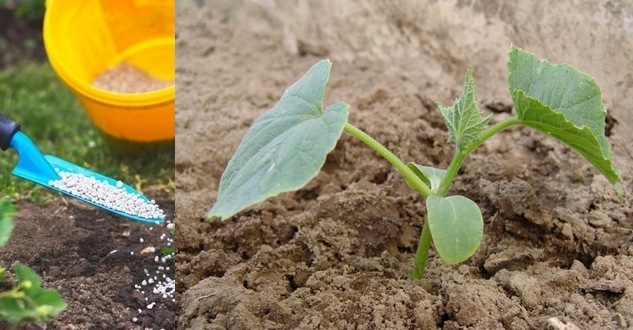
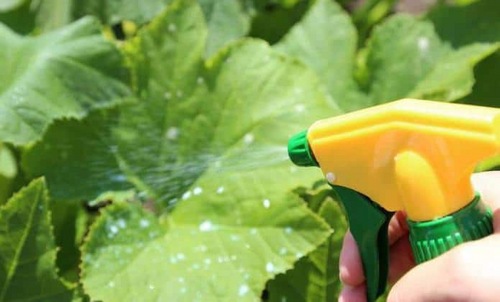
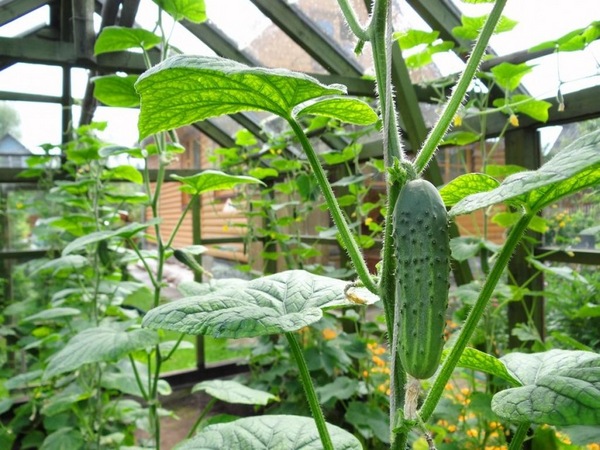
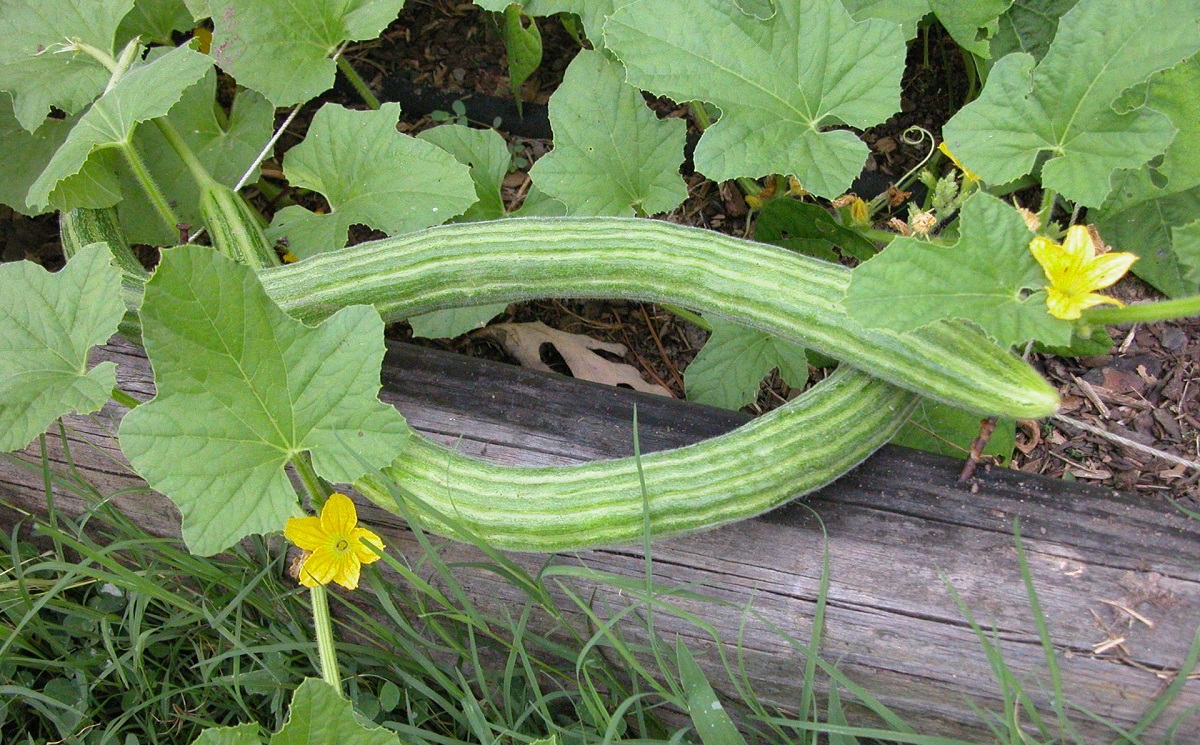 Armenian cucumber with melon flavor: description and characteristics, reviews
Armenian cucumber with melon flavor: description and characteristics, reviews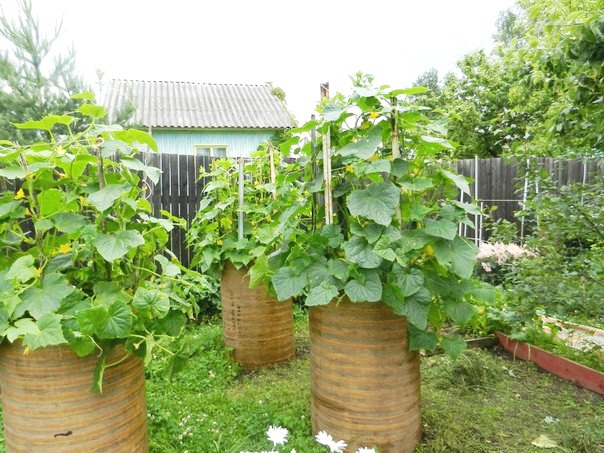 Do-it-yourself vertical beds for cucumbers: schemes, photos
Do-it-yourself vertical beds for cucumbers: schemes, photos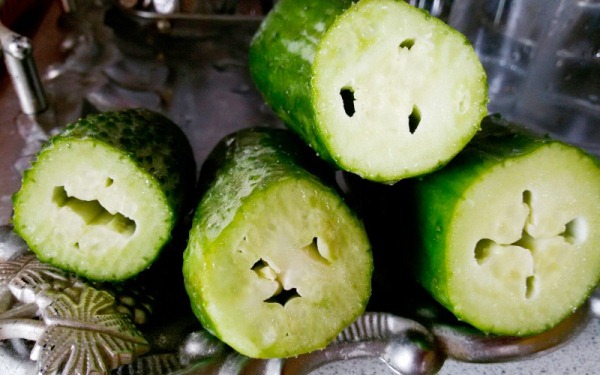 Hollow cucumbers: reasons for the appearance of hollow, what to do
Hollow cucumbers: reasons for the appearance of hollow, what to do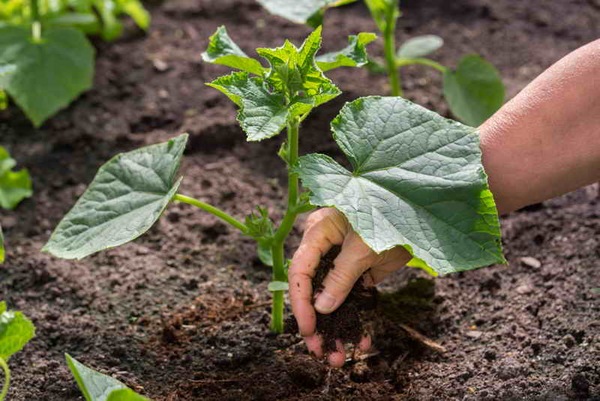 Which manure is best for cucumbers: application, how to breed
Which manure is best for cucumbers: application, how to breed